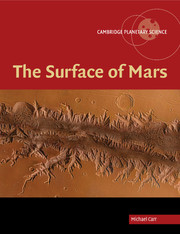10 - Poles
Published online by Cambridge University Press: 12 August 2009
Summary
The advance and retreat of the martian polar caps have been observed for almost two hundred years. The seasonal caps are solid CO2, a possibility that was recognized as early as the end of the nineteenth century. The prevailing view until the 1960s was, however, that the seasonal caps are water ice. This view changed when in 1965 Mariner 4 determined the surface pressure and it was realized that Mars had a thin atmosphere composed predominantly of CO2. In 1966 Leighton and Murray published a remarkably prescient paper in which they demonstrated not only that the seasonal caps are composed of CO2, but also that the atmospheric pressure must vary seasonally because of growth and dissipation of the caps. From temperature measurements and spectra, Mariners 6 and 7 soon confirmed that the seasonal caps are indeed CO2. Subsequently, the Viking orbiter instruments showed that during northern summer, the northern CO2 cap dissipates almost completely and uncovers a residual water-ice cap (Farmer et al., 1976; Kieffer et al., 1976). No water ice was detected at the south pole. More recently, however, water ice has been detected there beneath a meters-thick veneer of CO2 ice (Byrne and Ingersoll, 2003b). The CO2 ice appears to be dissipating on decadal time scales, creating strange patterns at the surface.
The unique geological characteristic of the poles is the presence of 3 km thick mounds of finely layered deposits.
- Type
- Chapter
- Information
- The Surface of Mars , pp. 211 - 228Publisher: Cambridge University PressPrint publication year: 2007



